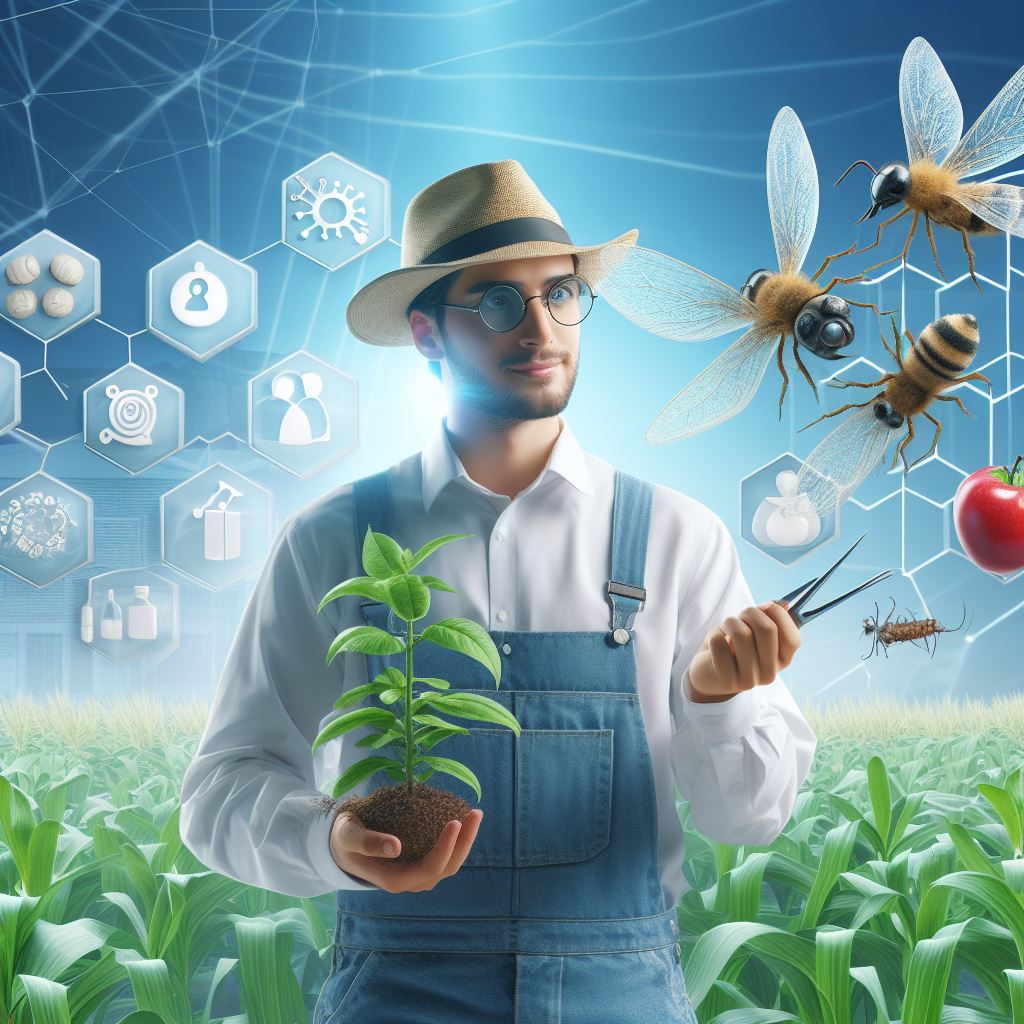Introduction
Agriculture heavily relies on biodiversity. Hedgerows, defined as linear rows of trees, shrubs, and grasses, hold the key to preserving and enhancing biodiversity on agricultural land.
Biodiversity is crucial for the health and productivity of agricultural ecosystems. It promotes pest control, pollination, nutrient cycling, and soil fertility.
Hedgerows are living fences that act as barriers or boundaries, often separating fields or marking property lines, and consist of diverse native plant species.
It plays a crucial role as highways of biodiversity on farms.
Hedgerows provide vital habitats and corridors for a wide range of species, connecting fragmented landscapes and promoting genetic diversity.
These natural boundaries offer nesting sites, food sources, and shelter for birds, insects, small mammals, and beneficial predators.
They act as windbreaks, reducing erosion, water runoff, and soil degradation, while also improving microclimate conditions.
Hedgerows enhance pollination services by attracting bees, butterflies, and other pollinators, ensuring bountiful crop yields.
They mitigate the spread of diseases and pests, serving as barriers that reduce the movement of harmful organisms between fields.
Moreover, hedgerows contribute to the aesthetic appeal of agricultural landscapes and provide recreational opportunities for nature lovers.
In short, hedgerows are essential elements of sustainable agriculture, functioning as vital networks of biodiversity that support ecosystem services and foster farm resilience.
The Role of Hedgerows in Promoting Biodiversity
Creating diverse habitats
Hedgerows, as natural linear habitats, play a pivotal role in promoting biodiversity.
These remarkable clusters of trees, shrubs, and plants contribute to the overall health and balance of ecosystems.
By occupying a variety of environments, hedgerows create diverse habitats that foster the growth and survival of numerous species.
Providing shelter and nesting sites for birds and small mammals
One key benefit of hedgerows is their ability to provide shelter and nesting sites for birds and small mammals.
Transform Your Agribusiness
Unlock your farm's potential with expert advice tailored to your needs. Get actionable steps that drive real results.
Get StartedThese animals rely on hedgerows as safe havens, protecting them from predators and adverse weather conditions.
The dense vegetation and structural complexity of hedgerows make them ideal habitats for biodiversity to flourish.
Offering food sources for insects, bees, and butterflies
Furthermore, hedgerows offer an essential food source for a plethora of insects, bees, and butterflies.
The flowers and foliage found within hedgerows attract these pollinators, which are crucial for plant reproduction.
Insects play an indispensable role in transferring pollen from one flower to another, facilitating fertilization and the production of fruit and seeds.
Therefore, hedgerows act as vital corridors that support the life cycles of various species.
Enhancing ecosystem services
Soil conservation and erosion prevention
In addition to creating diverse habitats, hedgerows enhance various ecosystem services. One primary function is soil conservation and erosion prevention.
The root systems of hedgerow plants stabilize the soil, minimizing erosion caused by water or wind.
This aspect is particularly crucial in agricultural landscapes, where hedgerows act as natural barriers, reducing the loss of valuable topsoil.
Pollination and pest control
Hedgerows also contribute to pollination, a process vital for the reproduction of flowering plants.
Pollinators, such as bees and butterflies, are attracted to the myriad of flowers found in hedgerows.
As these insects collect nectar or pollen, they inadvertently transfer the pollen from one flower to another.
This transfer leads to successful fertilization, ensuring the proliferation of plants and the survival of many species that depend on them.
Moreover, hedgerows provide natural pest control, reducing the reliance on harmful chemical interventions.
By creating habitats that attract a diverse range of insects, hedgerows encourage the presence of predatory species that feed on pests.
This ecological balance minimizes the need for synthetic pesticides, promoting a healthier and more sustainable environment.
Water purification and nutrient cycling
Lastly, hedgerows contribute to water purification and nutrient cycling. As water runs off the land, hedgerows act as natural filters, trapping sediments and pollutants.
This process improves water quality, benefiting both aquatic organisms and human communities downstream.
Additionally, hedgerows support nutrient cycling by storing and recycling organic matter, enriching the soil and promoting healthy plant growth.
In fact, hedgerows play a vital role in promoting biodiversity and maintaining ecosystem health.
By creating diverse habitats, hedgerows provide shelter, nesting sites, and food sources for numerous species.
They also enhance ecosystem services by conserving soil, facilitating pollination, controlling pests, and purifying water.
Recognizing the significance of hedgerows and implementing measures to protect and restore them is crucial for sustaining biodiversity and ensuring a balanced and thriving environment.
Read: Cover Crops: Guardians of Biodiversity
Showcase Your Farming Business
Publish your professional farming services profile on our blog for a one-time fee of $200 and reach a dedicated audience of farmers and agribusiness owners.
Publish Your ProfileBenefits of Biodiversity on Farms
Increased crop yield and resilience
Pollination and seed dispersal by insects and birds
Biodiversity on farms has numerous benefits, one of which is the increased crop yield and resilience.
Pollination, essential for the production of many crops, is performed by insects and birds.
They transfer pollen from the male parts of flowers to the female parts, leading to fertilization and the production of fruits and seeds.
Furthermore, insects and birds also aid in the dispersal of seeds, allowing for the expansion of plant populations.
Natural pest control through predator-prey relationships
In addition to pollination, biodiversity plays a crucial role in natural pest control on farms.
Predator-prey relationships between different organisms help maintain a balanced ecosystem.
For example, birds feed on insects that are harmful to crops, reducing the need for synthetic pesticides.
This promotes a healthier environment for both plants and animals, enhancing the overall productivity of the farm.
Improved soil health and fertility
Decomposition and nutrient cycling by soil organisms
The presence of diverse plant and animal species also contributes to improved soil health and fertility.Soil organisms, such as bacteria, fungi, and earthworms, play a vital role in decomposition and nutrient cycling.
They break down organic matter, releasing essential nutrients that are then available for uptake by plants.
This process improves soil fertility, ensuring that crops have access to the necessary nutrients for optimal growth.
Preventing soil erosion and promoting moisture retention
Biodiversity also plays a significant role in preventing soil erosion and promoting moisture retention.
Plant roots act as anchors, holding soil particles together and preventing them from being washed away by rainfall or winds.
The diverse vegetation also helps in absorbing and retaining water, reducing the risk of drought and improving overall water availability in the soil.
Economic and ecological sustainability
Reduced reliance on synthetic pesticides and fertilizers
Fostering biodiversity on farms contributes to both economic and ecological sustainability.
By maintaining a diverse range of plants and animals, farmers can reduce their reliance on synthetic pesticides and fertilizers.
Predatory insects and birds help control pest populations naturally, reducing the need for chemical intervention.
This not only saves costs but also minimizes the negative impacts of pesticides on the environment and human health.
Enhanced ecosystem resilience and long-term farm viability
Furthermore, increased biodiversity enhances the resilience of the farm’s ecosystem, promoting its long-term viability.
A diverse ecosystem is better equipped to withstand disturbances and adapt to changing environmental conditions.
This resilience contributes to stable crop production and reduces the vulnerability of farms to threats such as climate change, pests, and diseases.
In the long run, it ensures the sustainability and profitability of agricultural operations.
In essence, biodiversity on farms provides significant benefits that contribute to increased crop yield, improved soil health and fertility, and economic and ecological sustainability.
A rich variety of plant and animal species supports essential ecosystem services like pollination, natural pest control, nutrient cycling, soil erosion prevention, and moisture retention.
By recognizing the value of biodiversity and implementing practices that promote its conservation, farmers can create thriving and resilient agricultural systems.
Read: Natural Pest Control: A Biodiversity Ally
Conservation and Management of Hedgerows
Hedgerows are not only essential habitats for biodiversity, but they also provide numerous ecosystem services. To effectively conserve and manage hedgerows, certain practices need to be implemented.
This section will discuss various conservation and management strategies that can be employed to maximize the biodiversity and ecological value of hedgerows.
Designing hedgerows for maximum biodiversity
To enhance biodiversity within hedgerows, it is crucial to carefully select native plant species.
Native plants have co-evolved with local fauna and are better adapted to support diverse wildlife.
Incorporating diverse vegetation layers, such as trees, shrubs, and herbaceous plants, creates a more complex habitat that can accommodate a wider range of species.
Additionally, ensuring connectivity between hedgerows and other habitats, such as woodlands or wetlands, facilitates the movement of wildlife, promoting gene flow and species dispersal.
Maintenance practices
Regular maintenance is essential to keep hedgerows in optimal condition for biodiversity.
Trimming and hedgerow rejuvenation should be conducted on a regular basis to prevent overgrowth and maintain the desired structure.
However, it is important to avoid excessive or poorly timed trimming, as it may disrupt nesting birds or remove important food sources.
Chemical inputs, including pesticides and herbicides, should be avoided or minimized in hedgerow management to prevent harm to wildlife and maintain a healthy ecosystem.
Involving farmers and local communities
Farmers play a crucial role in hedgerow conservation and management.
Educating farmers about the benefits of hedgerows, such as improved pollination, pest control, and soil conservation, is essential to garner their support.
By understanding the ecological value of hedgerows, farmers can make informed decisions that prioritize biodiversity on their farms.
Furthermore, promoting policies that support hedgerow conservation and providing financial incentives can incentivize farmers to actively manage and restore hedgerows on their land.
Showcase Your Farming Business
Publish your professional farming services profile on our blog for a one-time fee of $200 and reach a dedicated audience of farmers and agribusiness owners.
Publish Your ProfileIn a nutshell, the conservation and management of hedgerows require a holistic approach that integrates ecological principles with practical considerations.
By designing hedgerows to maximize biodiversity, implementing proper maintenance practices, and involving farmers and local communities, we can ensure the long-term survival and ecological functionality of hedgerows.
These efforts not only benefit wildlife but also contribute to the overall sustainability of agricultural landscapes.
Read: Permaculture Principles for Biodiversity

Case Studies and Success Stories
Hedgerows have proven to be valuable additions to both organic farming systems and agroforestry systems.
Through the following case studies and success stories, the benefits of hedgerows are highlighted.
Example 1: Hedgerows in organic farming systems
One successful application of hedgerows is within organic farming systems.
These systems have seen notable improvements in crop yields and soil health due to the presence of hedgerows.
One significant benefit of hedgerows in organic farming is enhanced pollination and pest control.
The presence of diverse plant species in hedgerows attracts beneficial insects, such as bees and predatory insects, which aid in pollination and help control pest populations.
This symbiotic relationship results in higher crop yields for organic farmers.
Additionally, hedgerows contribute to improved soil health and reduced erosion.
The deep-rooted plants in hedgerows help bind the soil, minimizing erosion caused by wind and water.
Their roots also enhance soil structure, nutrient cycling, and water retention, leading to healthier soil conditions for farming.
Example 2: Hedgerow networks in agroforestry systems
Hedgerow networks have also shown success when integrated into agroforestry systems.
These systems benefit from increased wildlife diversity and habitat restoration, along with economic advantages.
The presence of hedgerows in agroforestry systems promotes increased wildlife diversity and habitat restoration.
Hedgerows provide shelter, nesting sites, and corridors for various species, such as birds, mammals, and insects.
This biodiversity contributes to a more balanced ecosystem, supporting the overall health and resilience of agroforestry systems.
Moreover, hedgerows in agroforestry systems bring economic benefits through diversification and additional income streams.
The varied plant species present in hedgerows can be utilized for various purposes, such as medicinal plants, fruits, nuts, or even timber production.
This diversification allows farmers to explore multiple income sources, reducing dependency on a single crop or activity.
In summary, both case studies and success stories demonstrate the positive impact hedgerows have on organic farming systems and agroforestry systems.
The enhanced pollination and pest control, improved soil health, increased wildlife diversity, and economic benefits make hedgerows a valuable asset in sustainable agricultural practices.
By incorporating hedgerows, farmers can promote biodiversity and achieve more resilient and productive farming systems.
Read: Conserving Water, Enriching Biodiversity
Conclusion
Throughout this blog section, we have explored the vital role of hedgerows as essential highways for biodiversity.
These linear habitats act as connective corridors, allowing wildlife to travel safely and access food, water, and shelter.
It is crucial that we advocate for the preservation and restoration of hedgerows.
Farmers can be encouraged to include hedgerows in their land-management practices, while policymakers must integrate the conservation of these valuable ecosystems in their agricultural policies.
Hedgerows offer countless benefits beyond biodiversity conservation. They can reduce soil erosion, regulate water flow, and provide pollination services.
By embracing hedgerows, we can achieve a harmonious balance between agriculture and the conservation of natural ecosystems, ensuring a sustainable future for both farming and biodiversity.




